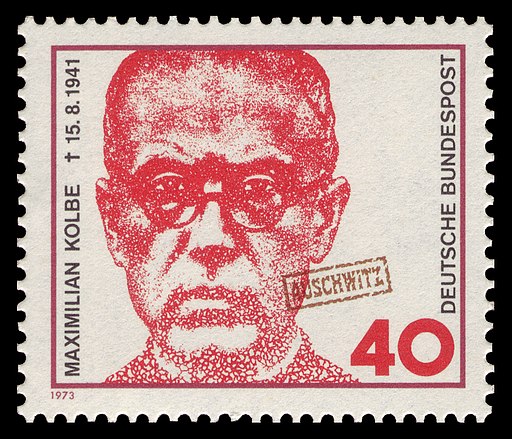
Maximilian Kolbe’s Legacy of Love and Sacrifice
Early Life
St. Maximilian Kolbe was born Raymond Kolbe in 1894 in Poland, then under the control of the Russian empire. His parents, Julius and Marianne, were pious, yet poor, Catholics. Julius joined the fight for Polish independence, eventually being arrested and hanged by the Russian authorities. Years later, his mother became a Benedictine nun.
Raymond entered the Franciscan junior seminary in Lwow, Poland and was accepted as a novice in 1910. When taking his first vows, he took on the name Maximilian; he made his final vows 1914, and was ordained a priest in 1918.
Devotion to Mary
Maximilian Kolbe's intense devotion to the Blessed Virgin began with a vision he received at age 12. In this vision, Mary appeared to the young boy holding a white crown in one hand and a red crown in the other, representing either a life of chastity or martyrdom, respectively. When asked to pick one, Kolbe accepted both.
His devotion flourished in religious life. In 1917, while studying for philosophy and theology doctorates in Rome, Kolbe founded the Militia Immaculatae, an evangelization movement dedicated to spreading Marian devotion and encouraging total consecration to her. He especially encouraged wearing the Miraculous Medal. He hoped through Mary's intercession to convert the enemies of the Church, particularly the Freemasons, whose blasphemy he had experienced firsthand in Rome.
Mass Media
In 1922, Kolbe began publishing a monthly magazine called Knight of the Immaculata. The magazine and Militia Immaculatae grew so substantially that Kolbe was able to found an apostolic center outside of Warsaw called Niepokalanow ('City of the Immaculata'), which contained a new Conventional Franciscan community, as well as a publishing house.
Once noting that “if we do not have Catholic media, our shrines will one day be empty," Kolbe was very aware of the power of media. The magazine did extremely well, reaching a peak circulation of around one million copies in the late 30s. Though not as popular as in the 20th century, the magazine is still in circulation today, over 100 years later. In addition to the magazine, Kolbe published other, smaller publications and also founded a radio station. His efforts continue to bear fruit beyond Niepokalanow; renowned Catholic figures such as Fulton Sheen and Bishop Robert Barron have followed in his footsteps by using mass media to spread the Gospel in the modern age.
Knight of the Immaculata covered a wide array of topics, from apologetics to politics. The magazine often voiced strong opposition to Nazism, even doing so after Germany occupied Poland in 1939.

Kolbe in WWII
Throughout the 1930s, Kolbe traveled throughout Asia doing missionary work, eventually establishing a monastery in Nagasaki, Japan and publishing Knight of the Immaculata in Japanese. Miraculously, the monastery was spared during the bombing of Nagasaki in 1945 because of its protective placement among the hills on the outskirts of the city.
Kolbe returned to a Europe on the brink of war. A few years after his return, Germany invaded Poland and in September of 1939, Kolbe and 55 of his community were arrested. A few months later, he was released. Knowing his influence within Poland, the Nazis offered him German citizenship, and therefore protection, in an attempt to curry his favor; Kolbe refused.
Though more limited in scope, he was allowed to continue publishing Knight of the Immaculata, through which he boldly continued to protest Nazi policy. Throughout the early years of the war, he and his fellow friars boarded refugees in Niepokalanow, including over 2,000 Jews escaping persecution.
In February 1941, the Gestapo arrested Kolbe and four others at Niepokalanow. He was transferred to Auschwitz in May and labelled prisoner 16670. For the few months he was imprisoned there, Kolbe showed remarkable humility and strength in the face of great evil. The guards singled him out for particularly degrading treatment, which he accepted calmly and submissively. He performed his priestly duties as best he could, preaching, praying and offering confession. He was able to twice secretly offer the Mass using smuggled hosts. Plagued with bad health for years, Kolbe's condition continued to deteriorate under the abysmal environment, and yet he never complained. Other prisoners attested to his selfless behavior despite his constant suffering.
In July of 1941, three prisoners successfully escaped from Auschwitz; in order to suppress further escape attempts, the guards decided to randomly choose ten prisoners to execute. One of the men chosen cried out for mercy, as he had a family. Maximilian Kolbe stepped forward to take his place, an exchange the guards accepted.
Kolbe and the nine others were condemned to starve to death. An eyewitness later recounted that Kolbe would lead the prisoners in prayer and song throughout their agony. After two weeks, Kolbe and three other men remained alive. The guards lethally injected them with carbolic acid, with Kolbe remaining calm and steadfast to the last. He died on August 14, the vigil of the Assumption of Mary.
Maximilian Kolbe's Canonization and Legacy
Maximilian Kolbe's cause for canonization opened in 1952 and he was canonized in 1982 by Pope St. John Paul II, a fellow Polish Catholic who lived through the horrors of WWII. John Paul II designated him as a martyr of charity. The man whose life he saved, Franciszek Gajowniczek, was present at his canonization; Gajowniczek died at the age of 93 in 1995 and is buried at Niepokalanow.
St. Maximilian Kolbe has become one of the most popular modern saints and has reached a certain level of renown outside the Catholic world, having died in the most infamous of Nazi concentration camps. However, its not just his selfless act of love in the end that made him so saintly, but also his enduring devotion to our Lord, the Blessed Mother, and living out the Gospel with boldness.
Living Liturgically with St. Maximilian Kolbe
Want to honor St. Maximilian Kolbe in your domestic church? You can do so daily by honoring the Blessed Mother, perhaps by reciting the rosary or singing a Marian hymn, like the Regina Caeli, with your family. You could also wear a Miraculous Medal, which Maximilian Kolbe greatly encouraged.
Other ways you could honor Maximilian Kolbe would be to become a pen pal with a prisoner, or volunteer at a prison or drug rehab center, since he is the patron saint of both prisoners and those struggling with addiction.
For his feast day, why not make a traditional Polish meal? You could try your hand at pierogis, bigos (a type of stew), or anything involving kielbasa and sauerkraut!
 St. Maximilian Kolbe Quotes
St. Maximilian Kolbe Quotes
"For Jesus Christ I am prepared to suffer still more."
"If angels could be jealous of men, they would be so for one reason: Holy Communion."
“Prayer is powerful beyond limits when we turn to the Immaculata, who is queen even of God’s heart.”
“The most deadly poison of our time is indifference. Let us strive, therefore, to praise Him (God) to the greatest extent of our powers.”
"The cross is the school of love."
“Christian perfection consists in the union of our will with the will of God.”
Frequently Asked Questions About St. Maximilian Kolbe
Who Is St. Maximilian Kolbe?
St. Maximilian Kolbe was a Catholic priest who is most well-known for his act of sacrificial love in Auschwitz, where he, as a prisoner, offered to switch places with another prisoner who had randomly been chosen to starve to death. After two weeks, Kolbe was still alive; the Nazi guards then gave him a lethal injection of carbolic acid. Prior to his imprisonment in Auschwitz, Kolbe became a Franciscan friar who created an evangelization movement called Militia Immaculatae and a magazine called Knight of the Immaculata, both of which were dedicated to spreading the Catholic faith through consecration to the Blessed Mother.
What is St. Maximilian Kolbe patron saint of?
St. Maximilian Kolbe is the patron saint of those suffering from addiction, prisoners (particularly political prisoners), the pro-life movement, families, and journalists.
When was St. Maximilian Kolbe canonized?
St. Maximilian Kolbe was canonized on October 10, 1982 by Pope St. John Paul II.
Why is St. Maximilian Kolbe a martyr of charity?
St. Maximilian Kolbe is considered a martyr of charity because he willingly gave his life so that Franciszek Gajowniczek could live. While traditional martyrdom is when someone dies for their belief in Christ, usually as a result of persecution, a martyr of charity is someone who dies as a consequence of their Christian action, or charity.
What happened to St. Maximilian Kolbe at Auschwitz?
St. Maximilian Kolbe was imprisoned at Auschwitz in 1941. When three prisoners escaped, the guards decided to randomly choose ten prisoners to execute in response. Maximilian Kolbe chose to take the place of one of the chosen men, who had a young family. Kolbe and the nine other prisoners were forcibly starved and dehydrated. When he was still alive after two weeks, the guards killed him by giving him a lethal injection of carbolic acid.
How is he portrayed in art?
St. Maximilian Kolbe is usually portrayed wearing his Franciscan habit with his striped Auschwitz camp shirt over one shoulder. He is often holding a rosary, to show his devotion to the Blessed Mother, and books or scrolls to symbolize his work as a writer and evangelizer. Sometimes he is shown holding the red and white crowns he saw in his vision of Mary as a young man.


Leave a comment